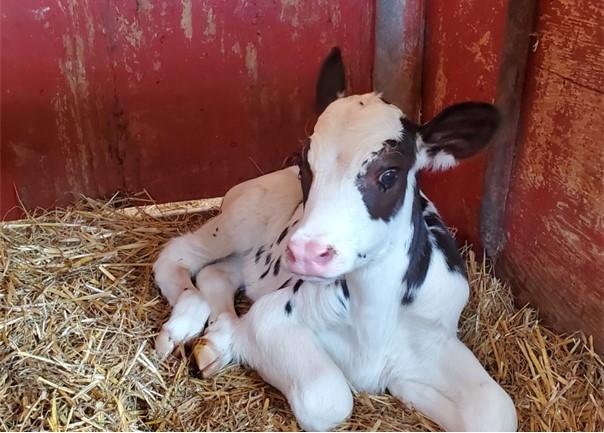Colostrum: Getting Calves off to a Good Start (FS-2022-0641)
Timing, quality, and quantity are three key components of a successful colostrum feeding program. Holstein calves should be fed three liters and Jersey calves should be fed two liters of high-quality colostrum (>50 grams IgG/mL or ≥21% Brix) within the first two hours of life and an additional two liters within 12 hours.; Author: Dr. Sarah Potts; Title: Colostrum: Getting Calves Off to a Good Start (FS-2022-0641)
Do pre-weaned calves need forage?
While it has been demonstrated that feeding hay is not needed to support adequate rumen development before weaning, there are some occasions when feeding a small amount of forage before weaning can be beneficial.
Do your heifers measure up? Tips for Evaluating your Heifer Program
Raising a replacement heifer to first calving is often the second or third largest expense on the dairy. Thus, it is important to fine-tune the heifer program to optimize heifer productivity and economic return. While the pre-weaned calf management program is a critical component of good heifer management, remember that management after weaning is also important.
Don’t Overlook Water For Young Calves
By Sarah Potts, Ph.D. Extension Specialist, Dairy & Beef
Published: October 12, 2022
Effect of an Improved Grazing Management System on Dairy Heifer Performance
A study at the Central Maryland Research and Education Center Clarksville Dairy farm to investigate the effects of improved grazing management on bred heifer performance. The objectives were to determine the effect of improved grazing management on heifer growth characteristics and first lactation performance, as well as the economic feasibility of a using a grazing system to mitigate costs associated with the replacement program.
Group Housing of Pre-weaned Calves: Yay or Nay?
Recent research suggests numerous benefits to housing pre-weaned calves in small groups, such as improved starter grain intake and greater social flexibility.
Managing Heifer Inventory on the Dairy
Many dairy producers grew up during a time when all heifer calves born on the farm were retained and reared as replacement candidates. However, improvements in pre-weaned calf management, heifer nutrition, and reproductive management have enabled dairy producers to maintain herd size while raising fewer replacements.
Milk Replacer: Are your calves getting enough?
Milk replacer was historically developed in order to spare salable milk. However, milk replacer is now valued for its ability to provide a convenient, safe, consistent, and cost-effective source of nutrients for pre-weaned calves so long as proper mixing and feeding protocols are followed.
Transition Milk May Benefit Dairy Calves
Most dairy producers are aware that providing calves with 3-5 quarts of high quality (>50 mg IgG/L) colostrum as soon as possible after birth is critical for ensuring transfer of passive immunity to get calves off to a good start. After the first 24 hours, many producers switch their calves to either a milk replacer or whole milk feeding regime. However, recent research suggests that there may be some benefits of feeding colostrum or transition milk for a longer period of time, even after the critical 24-hour window has passed.
Troubleshooting Calf Scours
By Sarah Potts, Ph.D., Extension Specialist, Dairy & Beef
Diarrhea, also known as scours, is the number one leading illness in dairy calves (respiratory infection is number two). Scours can lead dehydration, which, if severe, can...Read more
Research Update: Effect of an Improved Grazing Management System on Dairy Heifer Performance
This past spring, we initiated a study at the Central Maryland Research and Education Center Clarksville Dairy farm to investigate the effects of improved grazing management on bred heifer performance. The objectives were to determine the effect of improved grazing management on heifer growth characteristics and first lactation performance, as well as the economic feasibility of a using a grazing system to mitigate costs associated with the replacement program.
Understanding the Calving Process for Timely Intervention
Whether you are a dairy producer or a beef producer, raise your animals on pasture or in confinement, or prefer crossbreds to purebreds, at the end of the day, a bovine is a bovine. Regardless of your goals or operation size, calving is a universal process and its physiology is essentially the same for all bovines. Understanding the physiology of calving can help you better understand when and if intervention is necessary to ensure the health and wellbeing of your cows and calves.
Winter Calf Management Strategies
As the temperatures drop, there is more to calf care than putting jackets on them. Winter is always a challenge to calf raisers. We want our animals to have plenty of fresh air, which means caregivers are also exposed to colder temperatures.
Winter Calf Management Tips for Mitigating Illness
Although in our region we are not typically subjected to the brutally cold winters that are characteristic of the Upper Midwest, we are challenged by temperatures that fluctuate dramatically throughout the winter months. It is not uncommon for us to see temperature swings of 30 or 40°F on a given day, making management of pre-weaned calves difficult. However, reinforcing some basic housing and management concepts can help producers mitigate risks of calf illness throughout the winter.

